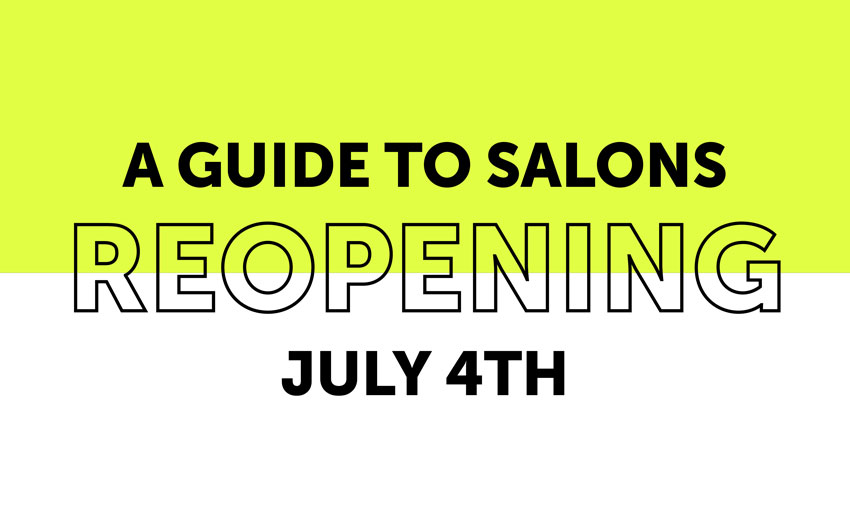
Having long anticipated the official reopening date for salons and barber shops, clients will finally be able to walk back into their favourite hair salon or barber shop on 4th July!
However, lack of government guidance on the specifics of keeping a salon safe from spreading the Coronavirus has been a point of worry for many salon owners – especially for nail and beauty salons who are still awaiting their return to work date.
This week though, official guidelines for those working in ‘close contact’ services was finally released, giving the hair and beauty industry more detailed advice on how to keep their employees and clients secure.
The term ‘close contact services’ covers all manner of hair and beauty businesses, including hairdressers, barber shops, beauty and nail bars, tattoo and spray tanning studios, spas, massage therapists and holistic practitioners.
While all of these businesses might not be greenlit for reopening yet, this advice still applies for when they can start welcoming clients back.
Read the full document for yourself here
What is the official guidance for close contact services?
We recommend you take a good look at the official government guidelines for yourself to see what information applies to you and how you can best implement it.
But, to get you started, here are a few of the main points to consider when reopening your salon…
Think about risks
It is advised that all employers should carry out a Covid-19 risk assessment.
If you need help doing this, you can find more information on the HSE website.
The purpose of this assessment should be to reduce any risks of transmission to the lowest practicable level, taking preventative measures as needed. The results should be shared with your team, with a notice displayed on your website and in your salon confirming you have taken this important step.
Keep your clients and staff safe
Make sure you protect the health of your clients and staff as much as possible, providing all salon hygiene supplies that are required, allowing for social distancing and limiting the number of people allowed in the building at any given time. Ensure everyone who works in and visits your salon understands what they need to do to stay safe.
Any should be toilets kept open and clean to help promote personal hygiene.
Think about who needs to go to work
If any of your team can work from home, they should continue to do so – any administrative staff or marketing team members, for example, should not be in the salon unless absolutely necessary.
If any of your team are considered vulnerable, they should only attend work when infection rates are low, or if they can maintain the full 2 metres of social distancing. Be mindful of any special needs or requirements your staff might have.
Anyone who has symptoms of COVID-19, or who lives with someone else who does, should stay at home.
Social distancing
Social distancing is still a key measure for returning to work. When 2 metres isn’t possible, 1 metre is acceptable with other mitigating actions, such as:
- Increased handwashing
- Keeping time involved as short as possible
- Using back-to-back or side-to-side working
- Wearing masks or using screens and visors
Reduce the need your staff have to move around the salon too much by equipping them with all their tools at their own work station. Try and keep the same staff members together on shifts to reduce too many people mixing together.
Cleaning the workplace
Make sure your salon has been thoroughly deep cleaned before it is reopened. Continue to maintain high salon hygiene practices to prevent contaminating surfaces and increasing the risk of transmission.
You will need to space appointments further apart to allow for cleaning between each client and use disposable gowns.
Provide hand washing facilities for staff and clients, or offer hand sanitiser when this isn’t possible. Any equipment that needs to be taken home should be cleaned beforehand, and again before it is brought back to the salon.
Use necessary salon PPE
Using salon PPE is particularly important when 2 metres of social distance cannot be maintained. It is advised that this takes the form of a face mask or covering, or a clear visor that should be cleaned often.
Remember – social distancing and good personal hygiene are still the best things you can do to prevent transmission. PPE should not be used instead of these, but as an additional layer of protection.
For staff or clients arriving on public transport, it is now required by law that they wear a face covering while travelling.
Related: A Guide to Using PPE in Your Salon
Create shift patterns and working groups
You might need to change the way your salon works to reduce the number of contacts each member of staff has. You can do this by creating ‘working groups’. In your rota or working schedule, try to keep the same staff members together as much as possible and stagger shift starting times.
Be sure to keep records of who was in the salon on any given day to help track and trace anyone who develops symptoms.
Accept deliveries with caution
Where possible, arrange contactless deliveries for all of your salon supplies. Try and take new stock into the salon outside of client appointments. Consider ordering larger quantities to reduce the number of deliveries needed.
We have more tips on how to reopen your salon or barber shop post-lockdown here.
We are doing our best to bring you all the salon PPE and salon hygiene equipment you need online at Salons Direct.
More advice from the Salons Direct Blog…
How to Use Perspex Screens in Your Salon | Are You Prepared to Deal With Post-Lockdown Hair Clients? | Helping Your Staff Through the Coronavirus Outbreak





